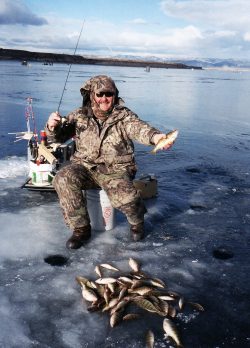LOCATING FISH
Ice fishing only becomes “Ice Catching” when you locate the fish. For some fishermen, a successful day is spent outside, drinking beer, smoking stogies and not having any fish to clean at the end of the day. We all know who I am talking about. This kind of fishing is fine.
The rest of us are really trying to catch fish. Ice fishing is meat fishing. We are after fish to eat! Most lakes offer little or no consumption warning. The perch, trout, and other species offer varying levels of healthy meals.
How do you locate the fish? Huge lakes or small ponds offer certain areas where fish will concentrate. Some lakes have geothermal features that offer warmer water. Channels and depressions may be filled with plankton. Submerged Christmas trees and debris offer cover and structure. Finding these areas means finding fish.
If you are fishing a new lake, look for geography. Points, narrows, dams, and channels are easily seen. Cut a series of holes. This line or grid of holes will be in varying depths. If you start near the shore, space your holes 10 yards apart. Fish each hole and see what happens. Your fish finders will display fish and depth along with water temperature. Fish often bite in the first few drops. Fish each hole for 10 minutes. Have your partner fish behind you using a different bait or rig. Once you begin to catch fish, concentrate on that area. Cut additional holes.
It is not uncommon to catch fish in a small area and no where else. Once you find these Honey Holes, use your GPS to remember them.
Look for fish sign you can see. Some fishy areas are identifiable above the ice. Rock islands, shore structure or places where a tree has fallen into the lake, or cloudy ice will produce fish. Using binoculars, you may see eagles or ravens on the ice. They are there to feed on fish parts left over from someone else’s good day of fishing. Evidence on the ice such as blood, fish parts, and heavy use could mean you are in a good spot. Cutting holes on the edges of cloudy ice is smart. Fish will be in the shade.
If fishing slows down, cut a line of holes away from your hot spot. Fish may move to deeper or shallower water as light declines or increases. Follow the fish.
Find the Fish and Catch the Fish, its that simple!
Montana Grant
For more Montana Grant, find him catching fish at www.montanagrantfishing.com or on Facebook.